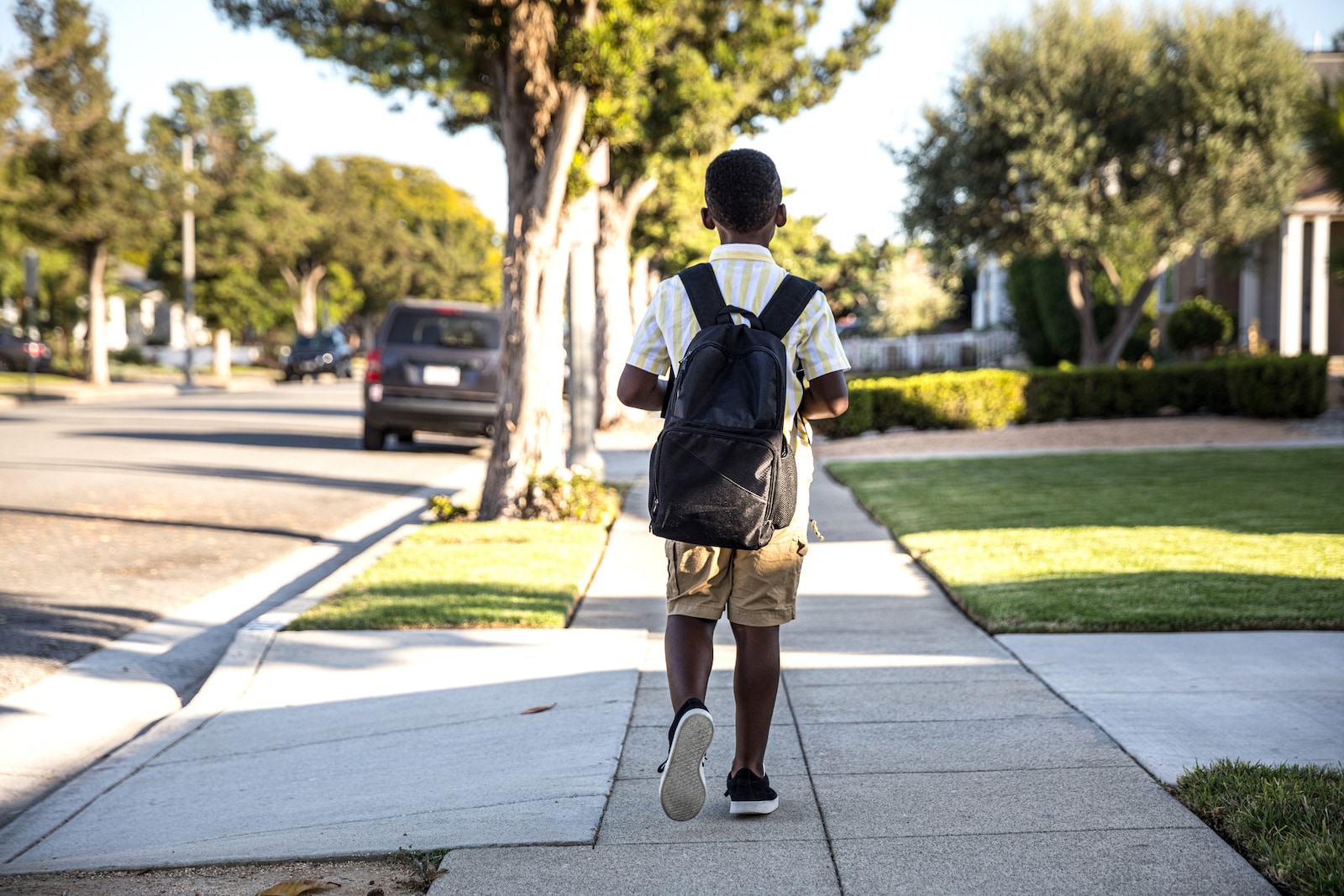In this article
Like staying home alone or getting a phone, for many big kids, walking to school is a rite of passage. Not only is it time to finally join the throngs of students shuffling to and fro, it’s also time for kids to flex some of their independent muscles by learning new skills and making smart decisions.
“There are wonderful benefits of letting kids walk to school on their own,” says Laura Gamino, OU Health injury prevention coordinator for trauma services and Safe Kids Oklahoma City Metro coalition coordinator. “In addition to the physical exercise and fresh air, walking to school helps kids develop independence and take responsibility for getting themselves to and from school on time.”
Of course, the million dollar parenting question is: When can kids start walking to school alone? Read on to hear what the experts suggest, along with important safety tips to consider.
Key takeaways
- Walking home from school builds independence, confidence and healthy habits in kids, with age 10 often recommended as a starting point.
- Readiness depends on maturity, safety awareness and route conditions.
- With preparation, it can be a rewarding and beneficial experience.
What’s the legal age to walk home from school alone in the U.S.?
Technically speaking, there’s no law about kids walking to school alone (or walking home), but the recommended age is 10. That said, as the case is with all things parenting, this age can be open for interpretation. “According to the American Academy of Pediatrics (AAP), kids are not ready to walk to school alone until about fifth grade or around age 10,” says Dr. Humaira Abid, assistant professor, Department of Child and Adolescent Psychiatry at the University of Oklahoma College of Medicine. “Younger kids are more impulsive and often do not fully understand potential dangers while walking alone to school. That said, some children as young as age 6 are able to walk to school if the route is simple and the child is walking with a group of friends.”
“In addition to the physical exercise and fresh air, walking to school helps kids develop independence and take responsibility for getting themselves to and from school on time.”
— Laura Gamino, injury prevention coordinator
More specifically, from a developmental standpoint, 10 is the age “most children are able to judge the speed and distance of oncoming cars,” explains Gamino.
If your child is around this age and you’re not sure whether or not they can handle the trek on their own, Dr. Sara Siddiqui, a pediatrician and clinical assistant professor in the Department of Pediatrics at NYU Langone’s Hassenfeld Children’s Hospital in New York advises taking the following into account:
- The child’s maturity.
- Their sense of direction.
- Their sense of safety.
“A child’s ability to communicate and ask questions if they’re unsure of anything is a good quality as well,” Siddiqui says. “Also, take into consideration the distance and types of roads on which they’ll be traveling.”
Signs your child isn’t ready to walk to school alone
Even if you’ve got a 10-year-old on your hands who’s relatively mature, they still may not be ready to walk home from school — particularly if the distance is far and the roads are busy. “If your child is easily distracted and not likely to always remember to look before crossing a street, then you may want to wait before letting them walk to or from school alone,” Abid points out. “As with other safety and health issues, trust your instincts.”
Something else to consider is how your child feels about walking alone. While some will jump at the chance to take on such a “big kid” task, others may not be so keen. “If a child is unwilling or does not feel comfortable, then they may not be ready to walk to and from school by themselves,” Siddiqui notes. “If that’s the case, though, it’s a good idea to ask what their fears are in order to help alleviate them.”
“According to the American Academy of Pediatrics (AAP), kids are not ready to walk to school alone until about fifth grade or around age 10.”
— Dr. Humaira Abid, assistant professor, Department of Child and Adolescent Psychiatry
How to prepare your child for walking home from school
Walking to and home from school is one of the few milestones parents can practice with their kids in order to help mitigate risks. In addition to teaching kids to look left, right and then left again before crossing the street at an early age, here’s how Gamino and Abid recommend prepping kids for their maiden voyage:
- Teach them to NEVER get in a car with a stranger. “Kids should never get in the car with any stranger or someone they know but hasn’t previously been established as a designated safe adult,” Gamino says, adding that an “emergency whistle” can be useful if kids are ever in trouble. “If someone ever tries to grab your child, teach them that they should kick, punch and hit as hard as they can and scream, ‘HELP, this is not my dad or this is not my mom!’ and then run away.”
- Teach kids to always walk on sidewalks and cross at street corners using traffic signals and crosswalks. “If there are no sidewalks, teach them to walk facing traffic as far to the left as possible,” Gamino says.
- Make sure kids make eye contact with drivers before crossing the street.
- Make sure kids are especially alert for cars that are turning or backing up.
- Make sure they never run or dart out into the street or cross between parked cars.
- When it is dark (or even approaching dark), teach them to be especially alert and make sure they are visible to drivers. “Wearing light or brightly colored clothing and reflective gear is safest,” Gamino says. “Using a flashlight also helps a child to be seen.”
- Make sure they’re not distracted walkers. “Head up, devices down!” Gamino stresses. “Phones, headphones and devices must be down when crossing the street. If talking on a phone is necessary, then kids need to stop walking and find a safe area to talk.”
“If a child is unwilling or does not feel comfortable, then they may not be ready to walk to and from school by themselves,”
— Dr. Sara Siddiqui, pediatrician
Siddiqui also suggests doing a trial run (or a few) before your child walks on their own. “I would recommend parents drive part of the way and have the child walk a short distance in the beginning, or accompany the child but from a distance to ensure safety,” she says, adding that, if possible, have kids walk in a group.
Is walking to school good for kids?
Some of the risks associated with kids walking to school on their own can sound downright terrifying; however, in addition to situations like stranger abductions being rare, so long as kids are properly prepared, the overall benefits outweigh them.
Here are a few of the upsides to letting kids walk to school on their own:
It increases physical activity
“Children should get at least 60 minutes of physical activity each day and a minimum of 12,000 steps — statistics show that the vast majority of school-aged children are not getting enough,” says Abid. “Walking to school is a simple way to help reverse this trend. Giving kids the opportunity to walk to and from school is also giving them a source of physical activity, which will increase metabolism and improve cardiopulmonary fitness.”
It can improve academic performance
“Some studies have shown that children who walk to school achieve higher academic performance,” says Abid. One experiment, conducted in 2018, found that “walking had a significant positive impact on cognitive test performance as measured through a 3-minute multiplication test administered post-walk.“
It’s relaxing
“Walking to school has also been associated with achieving a high degree of happiness, excitement and relaxation on the journey to school,” Abid adds. “Additionally, if they’re walking in a group, they’re bonding with peers.”
“Children benefit from being independent and trusted to begin making some of their own decisions.”
— Dr. Sara Siddiqui
It helps with time management
“For the longest time, our mornings were hectic and often ended in me shouting at my kids about being late to school,” says mom of three Jana Brady of Staten Island, New York. “Once they were in charge of their commute, magically, they started being on time.”
It can boost confidence
Laura Dodson of Flemington, New Jersey knew her 10-year-old daughter was responsible enough to walk to school on her own, but she wasn’t sure she had the confidence yet. “My daughter has always been a little nervous, so the idea of walking to school without her parents definitely made her a little anxious,” the mom of two says. “However, after doing it for a week or so, we saw a new confidence in her because she was doing something on her own. It’s been great for us and better for her.”
And Dodson’s experience isn’t uncommon. Given the opportunity to take care of themselves and make smart choices without parental interference, kids often rise to the occasion and are better for it. “Children benefit from being independent and trusted to begin making some of their own decisions,” Siddiqui says. “Walking to and from school safely can provide them with some opportunity for growth and development.”





